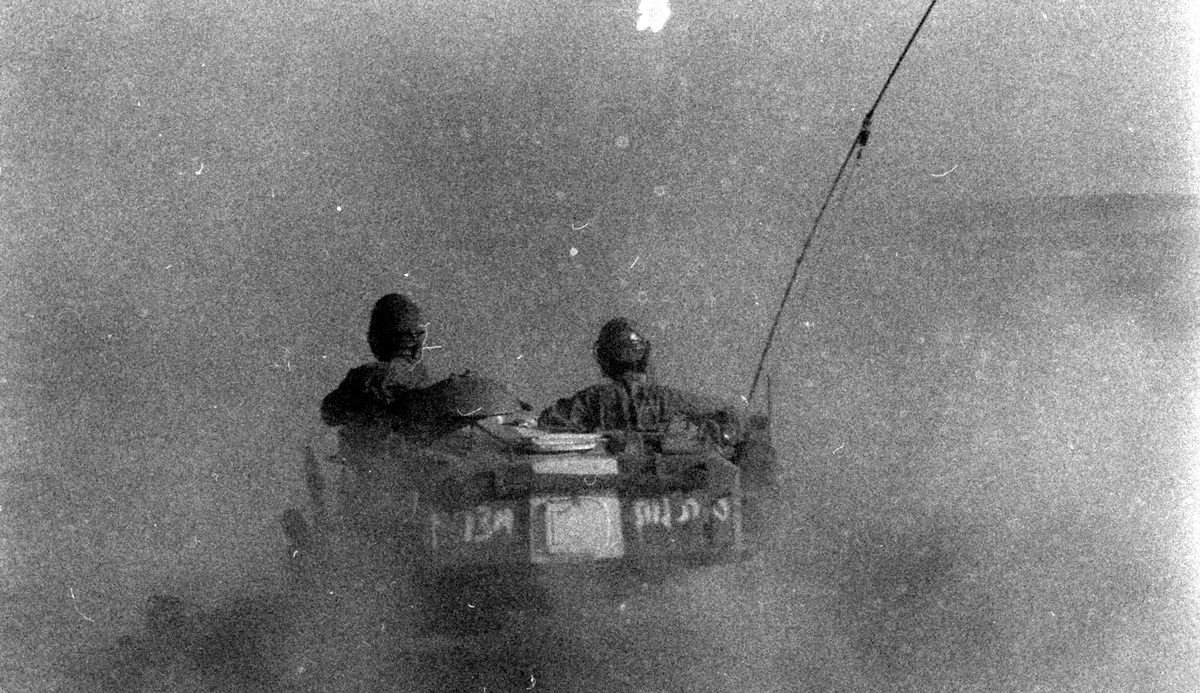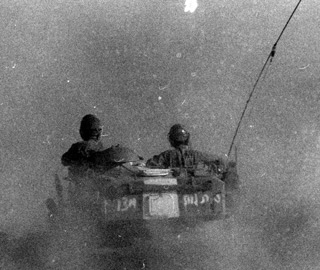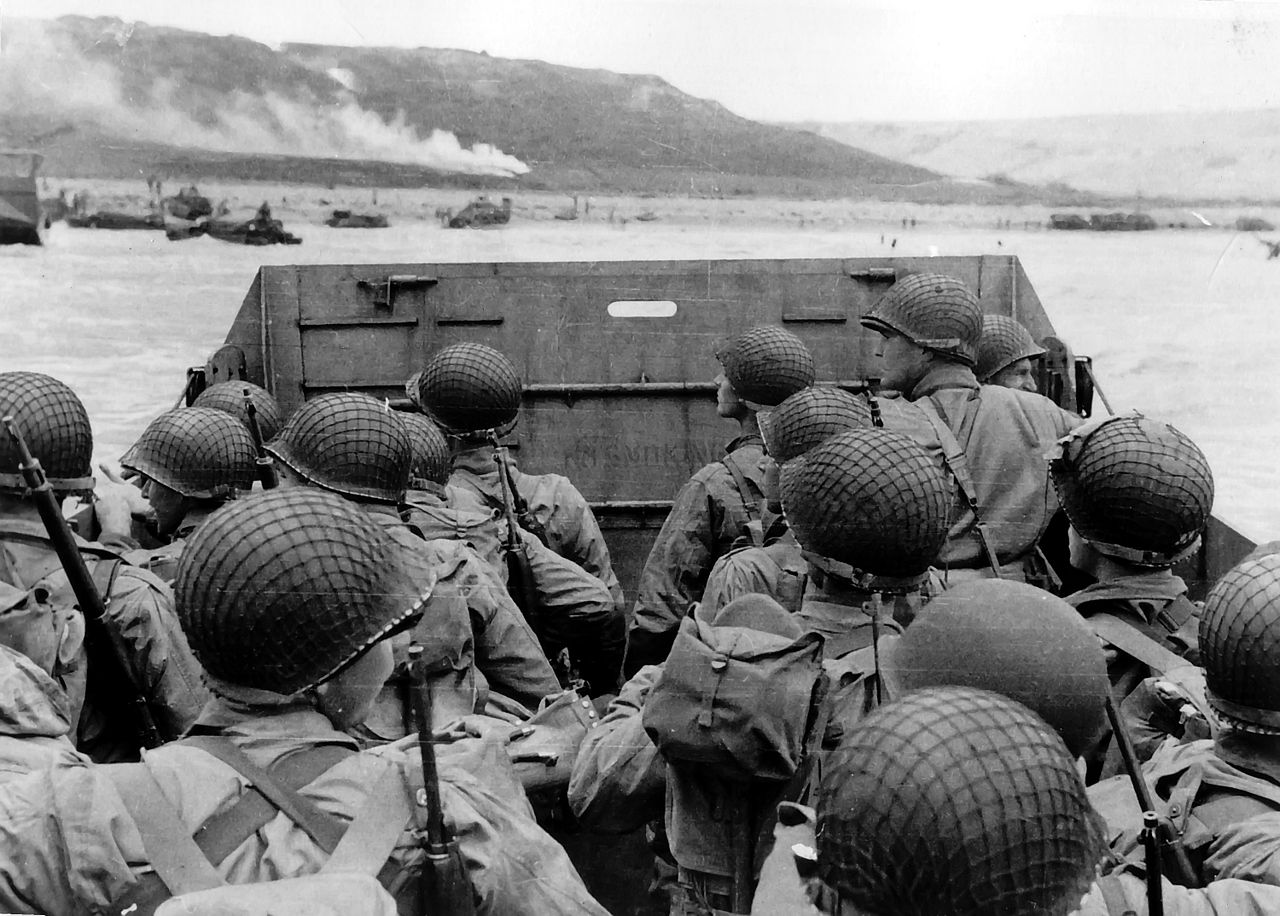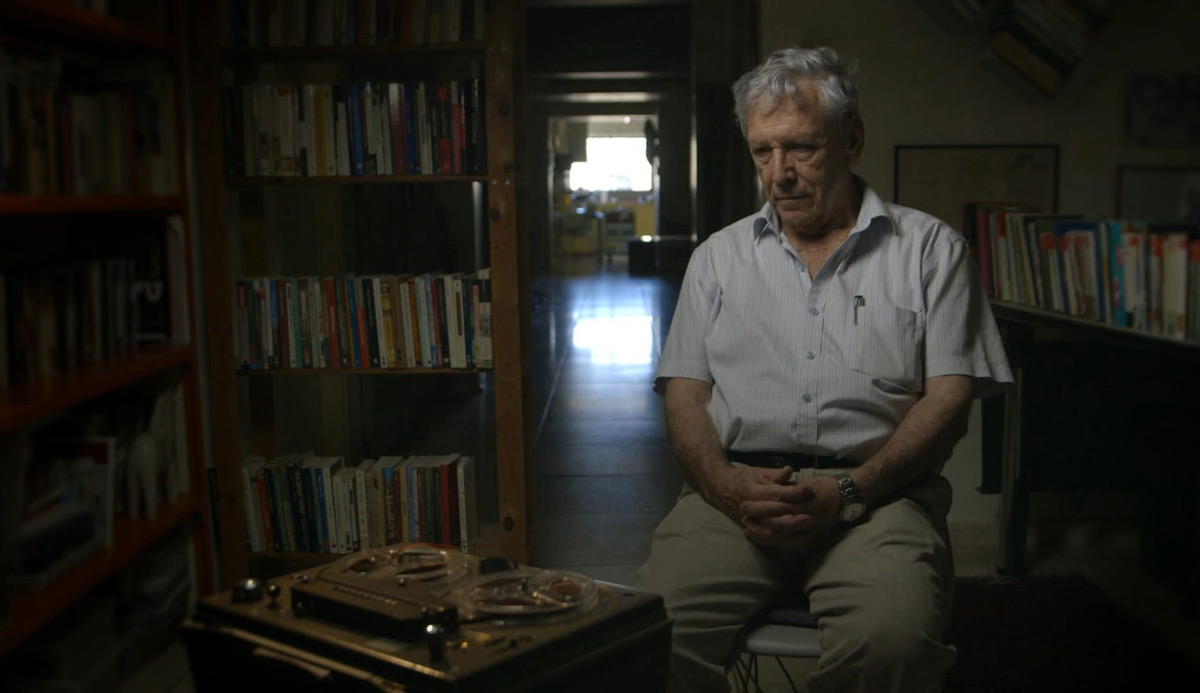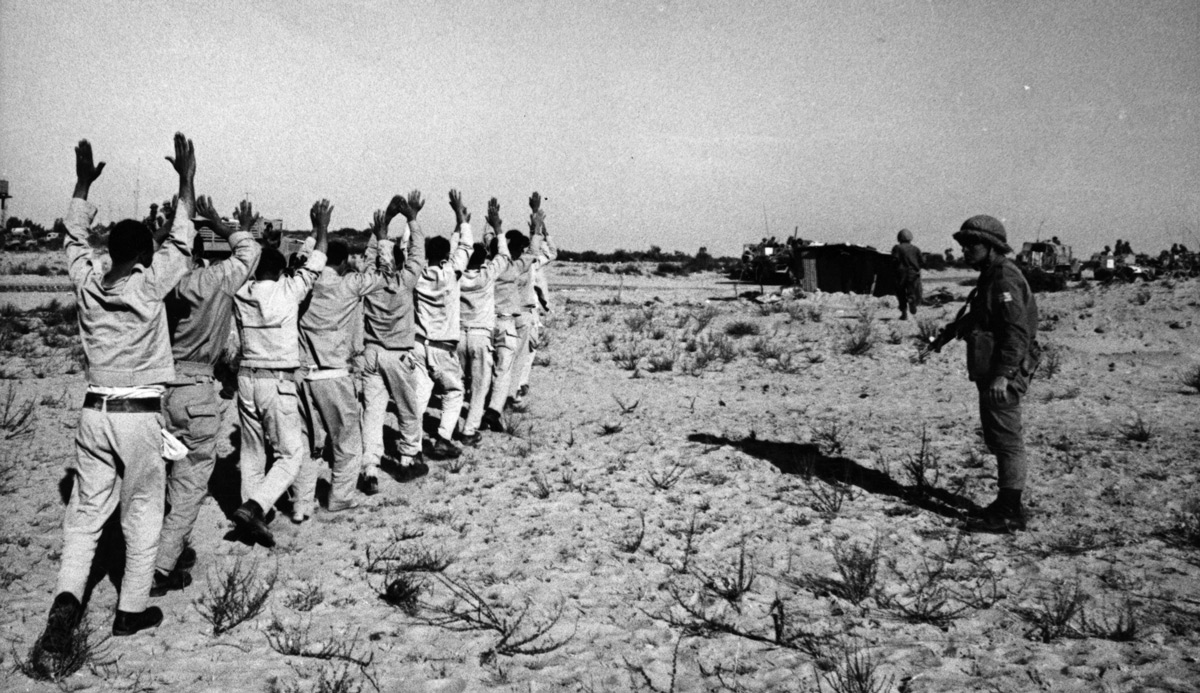On January 26 of this year, the New York Times ran a prominent article by its Jerusalem correspondent Jodi Rudoren about a new Israeli documentary then premiering at the Sundance Film Festival in Utah. According to Rudoren’s lengthy report, the film, Censored Voices, was an attention-grabbing exposé about the June 1967 Arab-Israeli war, also known as the Six-Day War, as told in conversations with soldiers conducted immediately after the war itself.
Since its Sundance debut, the $1 million Israeli-German co-production has been screened at festivals in Berlin, Florence, Geneva, Madrid, Toronto, Warsaw, and Zagreb. Its Israeli coming-out party took place at the Docaviv documentary film festival in Tel Aviv (where I saw it), and it is now showing in the country’s theaters, generating reviews and feature articles in the major daily newspapers. An Israeli documentary channel will televise the film in August. Rights have been sold in Canada, Australia, New Zealand, and across continental Europe, and the film’s sales agent will release it in Britain in the fall. An American distributor has purchased U.S. rights, and is planning a theatrical run later this year.
Censored Voices is likely to make as big a splash as The Gatekeepers, the 2012 documentary featuring six former heads of Israel’s secret-service agency—if not a bigger splash. And for the same reason: it stars Israelis indicting their own country for falling short of high standards in the conduct of war. And the film encourages the conclusion that the allegations about misconduct must be true, because the Israeli authorities censored the original interviews—in fact, they consigned fully 70 percent of them to oblivion.
Viewers, beware.
I. Self-Questioning in the Wake of ’67
First, the background.
Shortly after the June 1967 war, a book entitled Siaḥ Loḥamim (“Soldiers’ Talk”) appeared. It consisted of transcripts of tape-recorded discussions and interviews involving some 140 officers and soldiers, all kibbutz members. The initiators of these heart-to-hearts were themselves young kibbutznik intellectuals, most notably the educator Avraham Shapira and the then-rising young writer Amos Oz. (The latter is one of the aging stars of Censored Voices: a photo of him posed before a tape recorder, listening to his own testimony, was spread over three columns in the New York Times.)
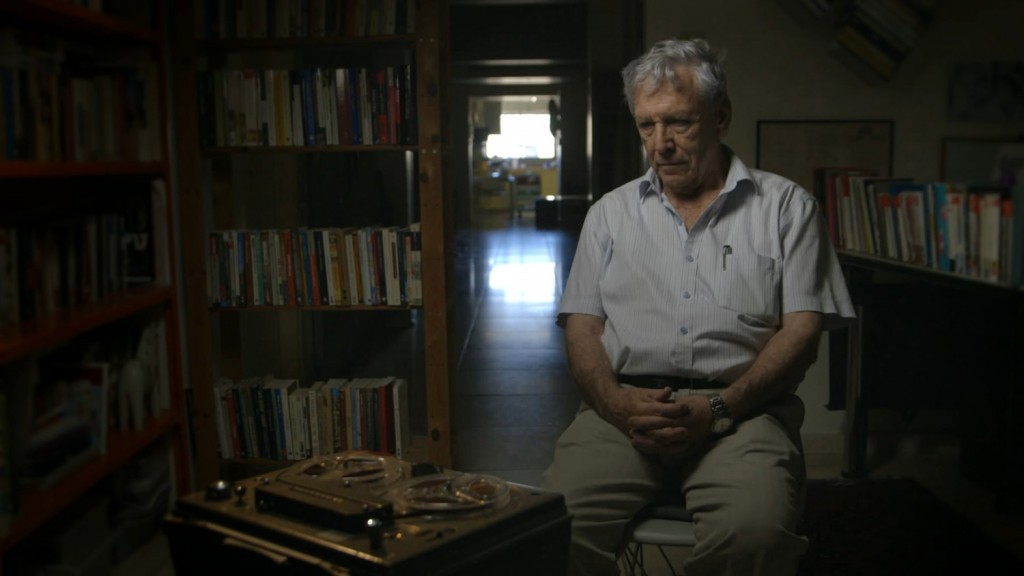
Amos Oz listens to testimony he gave after the Six-Day War, in which he fought. Photo by Avner Shahaf.
In the midst of the country’s widespread jubilation at its lightning victory over the combined forces of Egypt, Jordan, and Syria, the tape recorders had captured the dissenting voices of these fighters. They spoke of their gut-wrenching fear of combat, the cheapening of life in war, their revulsion at killing, and their unexpected feelings of identification with the Arab enemy. While most of the kibbutzniks saw the war as justified, some expressed doubts about the supposed sanctity of the conquered land, even of Jerusalem, and disgust at the incipient Israeli occupation. Hovering over it all was the Holocaust—primarily fear of its reenactment by Arabs against Israel’s Jews but also distress over seeming parallels between some of Israel’s actions and those of the Nazis in World War II.
The book struck a chord: Soldiers’ Talk was a phenomenal success, selling some 100,000 copies in Israel, and its kibbutznik editors and participants became minor celebrities, frequently appearing on the lecture circuit and in the media. Its fame also spread abroad: in the words of Elie Wiesel, this was “a very great book, very great,” thanks to “its integrity, its candor. No sleights of hand, no masks, no games. This is the truth, this is how it was.” Eventually the book was translated into a half-dozen languages, most notably in an abridged English version under the title The Seventh Day: Soldiers’ Talk About the Six-Day War. The dialogues even provided fodder for a play performed in New York.
Over the decades, as war followed war, Soldiers’ Talk was forgotten, or remembered only vaguely as the prototype of a genre mocked by both left and right and known pejoratively as “shooting and crying.” Most young Israelis today have never heard of it.
But they will have by now, and so will many others. A few years ago, Mor Loushy, an Israeli filmmaker at the start of her career, learned about the book in graduate school. Upon realizing that it drew on recorded conversations, she set out to find the original reel-to-reel tapes. According to Rudoren’s report in the Times, she then “cajoled” Avraham Shapira, the “aging kibbutznik and philosophy professor” who had been chief editor of Soldiers’ Talk, “to share the original audiotaped interviews that he had denied to legions of journalists and historians.” Loushy “spent eight months listening to 200 hours of the tapes,” identifying the voices and tracking down the former soldiers, now men on the cusp of old age.
In the finished film, the technique employed by Loushy to bring tapes and veterans together is arresting. The veterans are shown pensively listening to their own voices, recorded nearly a half-century ago, but they aren’t asked to reflect in retrospect, and there are no experts to fill in gaps. The effect is thus to transport the viewer back in time to 1967, and to create a sensation of eavesdropping on intimate confessions. The play-back of the tapes is overlaid at intervals with footage from 1967, selected to juxtapose the euphoria of victory against the dark side of the war. All of these techniques are on display in the movie’s trailer.
The most dramatic moments in the film come when soldiers testify to witnessing or perpetrating acts of brutality tantamount to war crimes. One soldier admits to lining people up and finishing them off: “It’s as though we murdered them. Practically, it’s war, and every civilian and every person is your enemy.” Another: “I knew I had to carry out orders. People were spotted up on the rooftops, I didn’t think at all whether they were civilians or not civilians, whether it was necessary to kill them or not. Everyone we see, we kill.” Another: “The next day we turned over the last 50 prisoners and at night we killed about 50 guys. The paratroopers let them bury them all and then an officer came up and finished off the rest of the prisoners, quickly, no problems.”
Soldiers also tell of expulsions: “We were ordered to carry out what was called evacuation of the inhabitants. You take this Arab, rooted in his village, and turn him into a refugee, just expel him from there, and not just one or two or three. When you see a whole village go, like sheep, wherever they’re taken, and there is no sign of resistance, you realize what Holocaust means.”
The bottom line, for one reviewer, is that the 1967 war emerges
not as an Israeli victory against annihilation at the hands of surrounding Arab countries, but as a nation’s questionable transformation from a defensive David to a Goliath who exiled and murdered Arab civilians to the bewilderment of its own troops.
Here, then, is the presumed reality of the 1967 war as experienced by those who fought in it. But did we not already know much if not all of this from Soldiers’ Talk itself? And if not, why not?
Enter now the promotional claim made by Loushy for her movie—and for her movie’s urgent timeliness. “The Israeli army,” she writes, “censored the recordings, allowing only a fragment of the conversations to be published” in the book. And because “the Israeli state had censored these conversations, so it also tells the story of fear. We have, as a society, silenced and denied other voices.” This being the case, she predicts that “the reemergence of those censored voices in Israeli society will undoubtedly stir a great storm,” and declares the special relevance of her film to “the present Israeli reality of our right-wing government still attempting to silence alternative voices.”
Loushy even puts a figure on the extent of the alleged suppression. Although the editors had “wanted to publish [these conversations] as a book,” she has been quoted as saying, “the Israeli censorship censored 70 percent of what they wanted to publish.” In this claim, Shapira himself has backed her up. In a May 30, 2015 report on Israel’s Channel 2, he appears with an open file before him. “Here on my desk is a small portion of 200 hours of transcribed conversations. We made a submission to the censor as was customary and required by law. The material was returned to us with approximately 70 percent of it deleted, completely deleted.”
This 70-percent figure has popped up regularly in news items and reviews, duly making an appearance in the American Jewish weeklies Forward and Jewish Journal: “The Israeli government censored 70 percent of the material. Shapira published the remaining 30 percent in his book.” And the figure has been picked up by the Economist: “70 percent of the interviews were censored at the time by the army, anxious that the soldiers’ stories of murdering prisoners, shooting civilians, and deporting Palestinian villagers should not cast a shadow over the glorious victory.” The film itself opens with the on-screen assertion that the military allowed only 30 percent of the recordings to be published: the only independent factual claim made in Censored Voices.
Is it true? As I watched Censored Voices gain momentum, something about its back story seemed to me implausible, and on closer examination my suspicions grew. So I followed them. It turns out that the history of Soldiers’ Talk is far from a simple tale of scandalous state censorship. Rather, there is compelling reason to doubt whether the military censor “brutally” (Loushy’s term) censored the conversations, or censored them much at all.
If that is so, as I hope to demonstrate in what follows, then the promotional hype surrounding Censored Voices is a deception. And if that is so, it casts into doubt the good faith of the filmmakers. After all, Censored Voices, like Soldiers’ Talk, is itself a product of careful selection. Its director asks us to trust her to have extracted those materials that are both factually sound and broadly representative of the Six-Day War.
Such trust would be sorely misplaced.
II. Censorship, or Self-Censorship?
Any inquiry into the editorial history of Soldiers’ Talk leads quickly to the work of Alon Gan, a third-generation kibbutznik who today teaches history at the Kibbutzim College of Education. In 2003, Gan completed a Tel Aviv University doctoral thesis on Soldiers’ Talk with the active assistance of Avraham Shapira himself. According to Gan, Shapira gave him access to the original tapes and transcripts. Here is how a 2005 kibbutz newspaper describes that access:
[Shapira] opened his private archive to Alon [Gan], his outstanding student, and revealed to him the raw material: tens of audio tapes kept at Yad Tabenkin [the kibbutz movement’s archives] and hundreds of pages of transcripts that had turned yellow in his home at [Kibbutz] Yizrael, for preparation of Alon’s doctoral thesis.
It was Gan who first discovered and documented the discrepancies between the taped conversations and the first edition of Soldiers’ Talk. Of course, much of the raw material was bound to be cut anyway. The conversations had produced 200 hours of tape. As one of the project’s interviewers would later recall, “most of the shelved tapes didn’t make the collection for trivial editorial reasons: narrowness of perspective, space limitations, avoiding endless repetitions. Heart-to-heart conversations took precedence over conversations whose participants had difficulty opening up .” “We had a lot of material,” said one of the editors, “and just a small part of it went into the book.”
Clearly, however, other editorial principles operated as well. Discarded in particular was material that didn’t suit the editors’ political agenda. Shapira’s interviewers, for example, had gone to Merkaz Harav Yeshiva in Jerusalem in the hope of finding religious soldiers troubled by the same doubts that afflicted the secular kibbutzniks. That five-hour conversation included soldiers who would later become some of the leading lights of the settler movement. Amram Hayisraeli, one of the kibbutzniks who participated in this dialogue, would later call it “perhaps the most important conversation” in the project. But when Amos Oz read the transcript, he broke into a rage: not one of the six religious soldiers “understood the pain, the moral problem, or that there was any problem at all.” Oz denounced them as “crude, smug, and arrogant,” and “as quite simply, inhuman.”
Shapira for his part opted to exclude the religious soldiers altogether, and then to dissimulate about it: “I decided that the conversations wouldn’t be included. . . . I didn’t reveal the real reasons to others, and I rationalized it by citing ‘technical reasons.'”
But the editors exercised self-censorship on their own side of the political spectrum, too. For instance: some soldiers had expressed either very radical leftist views or mentioned alleged atrocities against Arab civilians and POWs. In the published text, these references had been either eliminated or tucked under a heavy blanket of euphemism. As Gan’s dissertation reveals in some detail, the editors specifically tweaked and softened passages alleging actions that could be read as contradictory to the Israeli ideal of “purity of arms” or even as war crimes.
In brief, Shapira and his team carefully massaged the material that would enter the published text. Although Gan speculates that in any case “the external censor would not have permitted the editors to publish” certain materials,
it can’t be denied that the editors [themselves] created a picture that emphasized the positive side and the moral dimension in the soldiers’ conduct, and downplayed these descriptions. . . . . Different editing of the testimony would have presented the image of some of the soldiers and officers in a different light (or, more precisely, darkness).
“Of course there was censorship,” Gan concludes, “most of it by the editors themselves, whether for security reasons, or for societal-public reasons, or out of a sense of responsibility to the interviewees.” Above all, in Gan’s view, what motivated Shapira and his colleagues to make the cuts was
a sense of great public responsibility. It was obvious to them that some of the testimony was social dynamite, which should not be published in order not to divert attention from the general atmosphere that the editors wanted to make vivid to the reader.
III. 70 Percent
What happened next? As Gan documents, the “first edit, undertaken by Avraham Shapira [and] done without consideration for external censorship” was printed privately for circulation in kibbutzim. Clearly marked “internal, not for sale,” and issued between drab covers in October 1967, it didn’t trigger the need for approval by the censor.
But copies soon circulated beyond the kibbutzim, and the editors also sent copies to newsmen and writers. Mentions of the conversations and even excerpts from them began to appear in the press. As interest grew, the editors decided to pursue commercial publication—a step requiring submission of the private edition to the chief military censor, Col. Walter (Avner) Bar-On. There the project became stuck: according to Gan, “the chief censor proposed to delete nearly every politically loaded sentence, every sentence describing moral dilemmas such as looting, treatment of prisoners, refugees, etc.”
Had the process ended there, Soldiers’ Talk would have been gutted. But it didn’t end there. In January 1968, the editors contacted the army’s chief education officer, Col. Mordechai (“Morele”) Bar-On (no relation to Walter/Avner Bar-On), and pleaded for his intervention. Impressed by the project, he took it under his wing, asking the chief of staff, Lt. Gen. Yitzhak Rabin, for permission to assume responsibility for all content that didn’t expose military secrets. Rabin agreed, and Mordechai Bar-On became instrumental in seeing the project through censorship.
What deletions did the censor demand? In Shapira’s possession, there is a copy of the private edition marked with the many excisions and changes proposed by Walter Bar-On (in green) and the fewer ones suggested by Mordechai Bar-On (in blue). Together these would have made very substantial alterations to an already diluted text, constituting wholesale state censorship. Shapira and Oz rejected the proposed changes in toto; Oz was particularly vehement. A negotiation ensued. “I sat with Mordechai Bar-On,” Shapira said in a recent interview, “and together we went over the deletions of the censor, and what we could restore, we restored.”
The outcome? Gan saw the copy with the censors’ markings, and discovered that almost everything had been restored:
When one compares the public edition with the proposed changes of the censor [Walter Bar-On] and the proposals of Mordechai Bar-On, with the exception of a few changes, it is apparent that the stubbornness of the initiators of the collection to stick, almost exactly, to the first [private] edition, paid off. Mordechai Bar-On apparently accepted [the editors’] arguments and succeeded in persuading Walter Bar-On to agree to them.
The public edition, released in May 1968, carried the caveat that “minor alterations have been made” upon the editors’ judgment; Gan finds the alterations “indeed ‘minor.'” His unequivocal conclusion:
Aside from minor deletions, the public edition was largely if not entirely identical to the private edition. . . . On the basis of this evidence, it is apparent that the role of external censorship was small, in comparison to the censorship imposed by the initiators of the collection before the censor’s intervention.
If this is true, it is doubtful that either the chief censor or Mordechai Bar-On ever saw or heard any of the more disturbing allegations made by soldiers in Loushy’s film, all of which had been excised in advance by the editors in preparation of the private edition. Gan also quotes remarks to the same effect made in 1968 by the novelist and educator Yariv Ben-Aharon, one of the editors:
We imposed a severe censorship, we reworked and shortened and cut a lot, and also shelved. The official censorship deleted very little. It’s obvious that due to our censorship, there are some flaws in the book, and there are several misses. There are people who speak about killing in general, and the details aren’t in the book. This leaves the impression of self-righteousness.
In sum, the claim made by Loushy (and belatedly by Shapira) about massive state censorship of Soldiers’ Talk is directly contradicted by Gan’s in-depth study of the editorial history of the book. It is also directly contradicted by Yariv Ben-Aharon. And the accusation of “brutal” state censorship is similarly contradicted by Mordechai Bar-On, who was intimately involved in steering the text past the censor.
Bar-On, later one of the founders of Peace Now, is still active at eighty-six and takes some pride in the fact that he managed to get Soldiers’ Talk through military censorship with few changes. “I became the spokesperson for the book [in the army],” he recently recalled. “Here and there I softened some sentence, but overall, not much.” “I don’t remember today what we weeded from the text,” he has written in his recent autobiography, Child of the Previous Century: “not much, and anyway, they were things that the editors understood should be downplayed or softened.” When I asked him about the claim that the censor had nixed 70 percent of the material, he scoffed: “Maybe two or three percent.”
Mor Loushy never consulted Bar-On, who hadn’t even heard of Censored Voices when I asked him about it a few weeks after it premiered in Israel.
IV. Making Headlines
The scandal of official censorship, especially by the state of Israel, is headline-making; stringent self-censorship by a kibbutznik editor isn’t. That Loushy’s film benefits from her narrative of “brutal” censorship goes without saying, and that narrative has been deployed relentlessly in the promotion of Censored Voices.
But why has Shapira himself contributed to it? Some context is provided by earlier charges and counter-charges in the wake of Gan’s research.
Gan’s revelations, appearing as they did in an unpublished Ph.D. dissertation, didn’t draw attention in 2003. But that changed two years later when the Israeli journalist and historian Tom Segev devoted several pages to Soldiers’ Talk in his book 1967: Israel, the War, and the Year that Transformed the Middle East (pages 442–47 in the English edition). Segev, relying entirely on Gan’s dissertation, accused Shapira and his team of deliberate doctoring. “Parts of the transcripts were altered,” he wrote, “in a few cases to the point of distortion, before the book went to press, in order to suit the words to the image of innocent young soldiers, humanists in distress. . . . The editors were careful to avoid distancing the speakers from the national consensus—rather, they did just the opposite, placing them at its forefront and center.”
In a subsequent interview, Segev went further: “It’s amazing how thoroughly this thing was edited, censored, inauthentic. There was a confluence of interests between society, which needed an image like this, and the kibbutz, which needed an image like this. They invented this thing.” Benny Morris echoed the charge in a review of Segev’s book: “The original transcripts were altered and censored by the editors . . . [who] managed to create a ‘candid,’ moving, liberal antiwar text that bore only a partial resemblance to what was actually said in the original conversations.”
Suddenly the editors, and above all Avraham Shapira, stood publicly accused of tampering with the soldiers’ words in order to keep them within acceptable bounds. Shapira, who had been celebrated for initiating Soldiers’ Talk, now found himself in the dock for bowdlerizing it. “What Tom Segev attributes to me in his book and interview,” he replied, “is very hurtful, not only to the credibility of a central area of my work since 1960, but to my own human character.” For his part, Gan, on whose dissertation Segev had relied, recoiled at this use of his work: “To attribute to [Shapira] manipulation, distortion, and deliberate myth-making is unfair and incorrect. . . . Segev made claims, in my name, that I didn’t intend.”
Whether Shapira’s editing robbed Soldiers’ Talk of its integrity is debatable. But one thing is certain: faced with this criticism, he didn’t offer the excuse of military censorship. To the contrary, he insisted: “I take upon myself full and total responsibility for the editing of Soldiers’ Talk in its book form—internal responsibility toward all of the participants, and public responsibility.”
Shapira nonetheless learned his lesson. By allowing Gan to compare the book with the original transcripts, he had exposed himself to withering criticism, mostly from Israel’s revisionist school of “new historians.” In that light, it isn’t hard to understand why he later cold-shouldered other journalists and historians anxious to see the original transcripts. As reported by Loushy, “A lot of major news outlets from Israel tried to take [the material] from [Shapira] and so did foreign journalists. He never agreed to give it to anyone.” And no wonder: their aim would have been to expose still more gaps between what was said and what was published.
Why, then, did he give that access to Loushy, a recent film graduate with only one earlier production to her name, and a person no less eager to uncover still more gaps? Loushy attributes it to personal chemistry:
I started chasing after him and at first he didn’t answer my calls. Finally I went to a lecture that he gave. Immediately he told me, “OK, come to my kibbutz.” From the first moment we met, there was something there. I don’t know how but he believed in me and we started this amazing journey together.
This is all very cinematic: the wizened old guru impulsively yields to the importunities of an eager young acolyte, and grants her unconditional access to his locked treasure chest of secrets. Perhaps it’s true. Yet Loushy, who desperately needed Shapira’s cooperation to make her movie, was evidently prepared to do something today that Alon Gan, in a supervised and refereed Ph.D. dissertation, could never have done in 2003: absolve Shapira of any blame for self-censoring the book.
Did Shapira suggest this to her? Was it her idea? Whatever the precise origins of the claim of a “brutal” 70-percent official censorship, it conveniently lifted the stigma from Shapira. (“Yes, there was censorship,” he has said in a new interview, “and it wasn’t by us.”) It also conferred on Loushy’s “scoop” the strong whiff of scandal that attends to official cover-ups. Israel’s soldiers not only committed crimes, but Israel’s military censor then tried to conceal them. State censorship of atrocity stories can be read as a de-facto admission of their veracity.
V. The Trouble with War Stories
What, then, of the stories told by the soldiers? It would be naive to assume that Israeli soldiers were incapable of committing any of the acts they describe in the film. Expulsions and killings of civilians and even prisoners had precedents in 1948 and 1956. But it would be just as naive to assume that the events unfolded as the soldiers described them.
This is due to the usual trouble with war stories—they mutate and grow in the telling. That isn’t a cliché. A body of research, mostly in relation to veterans’ claims of post-traumatic stress disorder, has analyzed and quantified the problem. One influential study established that nearly 40 percent of Vietnam veterans who claimed to have experienced combat-related stress hadn’t had combat exposure in the first place. They were also the ones who more commonly described having witnessed or committed battlefield atrocities. Sir Simon Wessely, the prominent psychiatrist, has summarized the conclusion this way: “War stories change according to who is doing the telling, who is doing the listening, and why the story is being told now.” If one’s view is that Israeli soldiers are no more virtuous than other soldiers, one must accept that their testimonies are no more reliable, either.
The historian’s solution is to take soldiers’ accounts as a point of departure, and then cross-reference them with other sources. The problem with the concept of Soldiers’ Talk is that it wasn’t meant to assemble the evidence that would make this possible. Amos Oz, himself a writer of fiction, set the tone for the project from the beginning: talk not about what you did during the war, he instructed participants, but about what you experienced. “The key word here,” Oz recently reminisced, “is what you felt.” Soldiers’ Talk wasn’t a project to uncover and document war crimes. It was about eliciting the emotions of the soldiers, in a way more consistent with internal group therapy than with investigation. As a result, the organizers made no effort to collect and corroborate details about specific events, and soldiers gave no names, places, or dates.
Not only does Censored Voices make no attempt to fill in the missing details. It further obfuscates the picture. Footage is shown to illustrate some of the claims—bodies of enemy soldiers strewn along the road, refugees trudging with their possessions on their backs—but it isn’t actual footage of the scenes described by the speaking soldiers, and it bears no identifying captions. We hear voices making confessions or allegations, but we don’t know who is speaking, and the soldiers are identified by name only at the end. (“For the most part,” notes one American reviewer, “the men are treated as interchangeable.”) In these circumstances, the veracity of any individual allegation is difficult if not impossible to establish.
But let us assume for argument’s sake that the actions described in Censored Voices took place as described. Let us even assume that the instances Loushy did not include—she claims there are dozens more—have some grain of truth in them. Would this warrant a revision of the way Israel and the world see the 1967 war? Hardly.
Expulsions of Palestinian Arabs? A few instances (above all, villages in the Latrun salient) are well-attested, but no expulsion affected more than a few thousand people, and some of those expelled were allowed to return (most notably, to Qalqiliya). A much larger number, 200,000, left the West Bank of Jordan for the East Bank. A UN special representative who visited in July 1967 said in a report that he had “received no specific reports indicating that persons had been physically forced to cross to the East Bank.” After mentioning Israel’s claims that it had not “encouraged” their departure, and Arab allegations of brutality and intimidation, the report singled out “the inevitable impact upon a frightened civilian population of hostilities and military occupation as such, particularly when no measures of reassurance are taken.” In short, they fled.
When all was said and done, the 1967 war did not result in the massive displacement of Palestinian Arabs that characterized the war of 1948. That earlier war had emptied entire Arab cities: Jaffa, Lydda, Ramla. The 1967 war emptied none. Instead, it ended with Israel in occupation of solidly Palestinian Arab territories. Censored Voices conveys the impression that 1967 had an impact on the Palestinians similar to 1948, when in fact its character and consequences could not have been more different.
Killings of prisoners and surrendering or fleeing enemy soldiers? These happened, and we can infer it from Yeshayahu Gavish, who was head of Israel’s Southern Command in 1967. In a debriefing after the war, he referred to the confusion regarding Egyptian prisoners:
The blame falls on me, not on the staff. It is true that we didn’t know what to do with the prisoners. . . . Our conflict in this war was to destroy the enemy—that was the order, and it is pretty stupid to put in the same sentence, “destroy the enemy” and “take prisoners.” It wasn’t resolved. It began in the first stage, and later we had to deal with the prisoners, and it became clear that destroying the enemy had a certain meaning, with a huge percentage of them wandering around in the field.
But the confusion didn’t last. Israel ultimately took 6,000 Egyptian prisoners, and thousands more were sent on their way to the Suez Canal (where, according to some Israeli witnesses, Egyptian forces initially fired on them for retreating). After the war, Israel collected Egyptian stragglers from all over Sinai and sent them home. The International Committee of the Red Cross (ICRC) reported this operation in July 1967:
A large number of Egyptian soldiers were in dire straits in the Sinai Desert after the cease-fire. The ICRC delegates were active in the rescue operations, responsibility for which was assumed first and foremost by the Israeli authorities. These operations were made difficult by the fact that the territory was enormous and that many of the soldiers were widely dispersed. They had often to be sought by helicopter, sometimes one by one, and supplies had to be taken to them by tank-lorries. Some 12,000 troops were enabled to return to their home country. The conveyance of isolated troops towards the eastern bank of the Suez Canal and then to the other side was continued until, by the end of June, the operation was nearing completion.
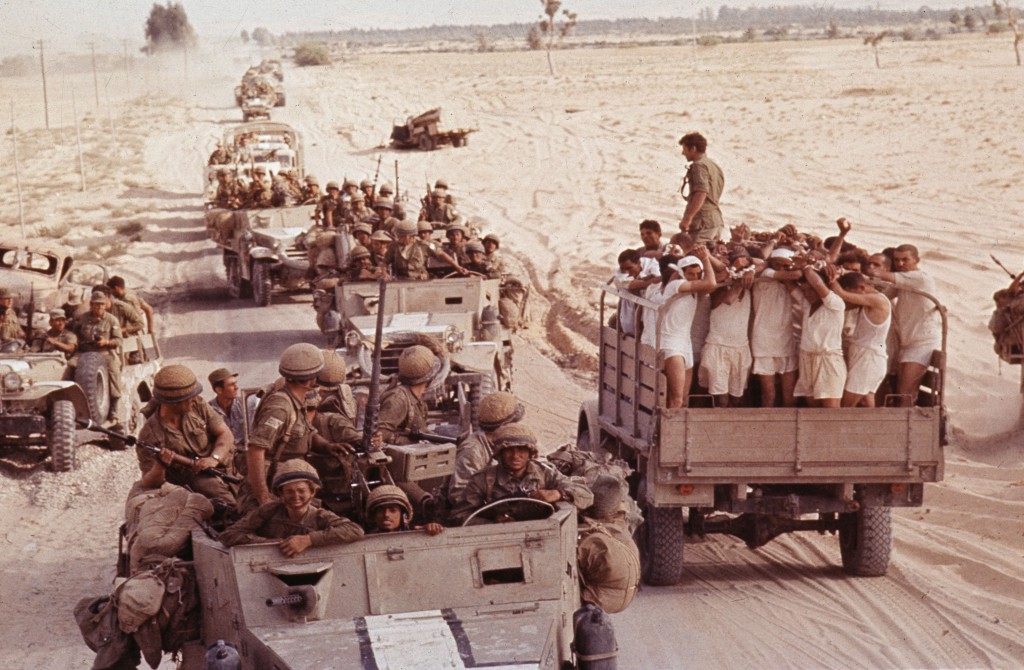
Captured Egyptian soldiers are transported by an Israeli armored convoy to a prisoner of war camp in 1967. Rolls Press/Popperfoto/Getty Images.
“I am not saying there were no aberrations,” allowed then-Prime Minister Yitzhak Rabin in 1995, during an earlier round of claims about prisoners killed in the 1967 war. But “these events were real exceptions.” Prominent Israeli chroniclers of the war have likewise referred to these as “isolated incidents of Israeli abuses” (Michael Oren) and “isolated acts of abuse” (Yossi Klein Halevi). If this is true, then the high-resolution focus on such cases in Censored Voices is wildly disproportionate. “There were ugly things,” said one of the original interviewees upon viewing the film, “but to turn them into such a severe situation, it’s exaggerated. . . . . Suddenly, in the eyes of my grandson, I will seem like someone who kills prisoners and expels people. It’s not true.”
Do such instances, however many they may be, negate or detract from the Israeli narrative of the necessity and justice of the war? Or are they simply evidence that even necessary and just wars aren’t ever waged entirely within the rules? The answer of Censored Voices to this question is not all that different from the answer given by Breaking the Silence, an Israeli NGO that collects and disseminates testimony of unnamed Israeli soldiers who claim to have witnessed war crimes. Both seize upon events that may be isolated occurrences and isolate them still further, ripping them from their broader context and waving them like bloodied sheets. If Israel cannot wage perfect war, the premise goes, it must not wage war at all, even in its own defense.
The methodology of Censored Voices is even more selective than that of Israel-bashing NGOs. Loushy chose events based on the additional criterion of entertainment value. Danny Sivan, the film’s producer (and Loushy’s partner) has admitted that they didn’t want “stories that just transmit information, but that do something to you in the gut, into order to create an emotional cinematic experience and not just an informative document.”
Admittedly, a movie theater isn’t the ideal setting for forensic analysis of something so complex as a fast-moving, three-front war that changed Israel and the Middle East. A film is not a book or a Ph.D. dissertation. The problem is that, for many of its viewers, Censored Voices is likely to be their only encounter with the 1967 war. How many of them are even capable of setting what they have watched in context? For that matter, how many reviewers are so capable? Given the widespread ignorance of Israel’s history, even among Israelis, the number is distressingly small.
Of course, this perfectly suits Israel’s critics at home and abroad. After almost 50 years of “occupation,” they are so embittered that they will automatically retail the worst about Israel’s conduct in 1967 without so much as a caveat. If the occupation is an ongoing sin, then it must have been conceived in original sin. Not only does Censored Voices benefit from this suspension of critical judgment. It depends on it.
VI. Whither Public Responsibility?
An Israeli columnist, reacting to the film, has written that Loushy’s “naiveté exceeds that of a flower child from the 1960s.”
Far from it. Every Israeli who hopes to earn fame by making documentaries knows there is a persistent demand for films exposing Israel’s misdeeds, especially if they are attested by Israelis themselves. And nothing is so marketable as a story exposing crimes covered up by the state itself. The formula is irresistible to film-festival directors, high-brow European television channels, and the New York Times. Loushy, a graduate of Israel’s best-known film school, aimed her film with manipulative precision. Her savvy grasp of the market explains her single-minded selection of content and, more importantly, her steady propagation of the “brutal” censorship meme, seemingly made more credible by giving it a number.
In fact, as I have shown, the claim detracts from the credibility of the film. The voices in Censored Voices weren’t censored, they were heavily redacted, and by the very man, Avraham Shapira, whom Mor Loushy warmly embraced on the stage at the Tel Aviv premiere. “If those voices had been published in 1967,” Loushy told the New York Times, “maybe our reality here would be different.” That’s an open question. But she has deliberately deflected her complaint onto the wrong party.
Behind this deception lurks the really interesting back story of Soldiers’ Talk. Muki Tzur, another of the book’s editors, has recalled that in 1967, “the country still had the aspect of an underground society that kept its secrets, believing in the value of self-censorship.” Once upon a time, Israel’s intellectual elites, even on the left, still felt enough public responsibility to restrain themselves. Now their successors are busy elves in a cottage industry catering to the world’s critics of Israel—doubters, defamers, delegitimizers. It’s not only that they broadcast unsubstantiated claims and strip away all context. They also go on to spew bogus accusations of “silencing” and “censoring”—to create the impression that the state of Israel is engaged in the massive cover-up of crimes.
Censored Voices, beginning with its title, fabricates such an accusation right out of the gate. Its theatrical rollout in the United States will qualify it to be considered for an Oscar nomination in the documentary feature category.
Audiences, on guard. Academy, beware.
———
A PDF version of this essay containing links to Hebrew sources not linked to above is available here.
More about: Arts & Culture, Film, Israel & Zionism, Six-Day War
